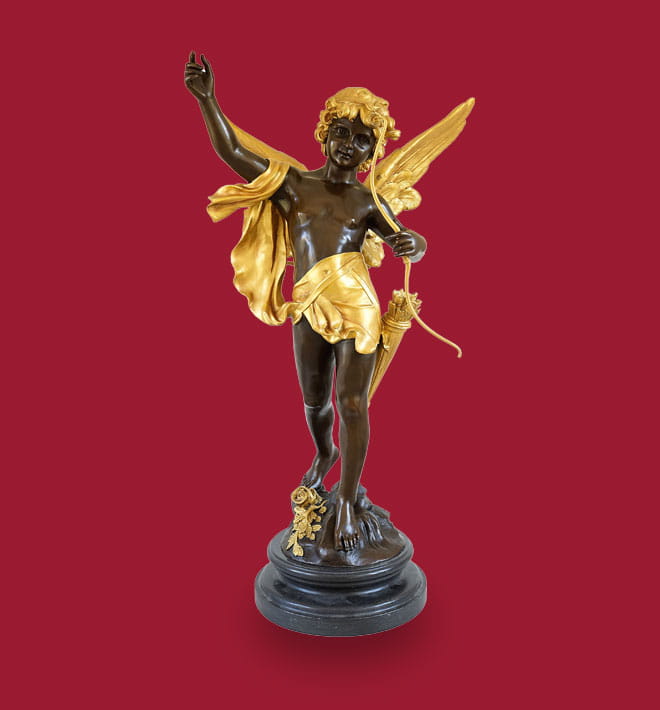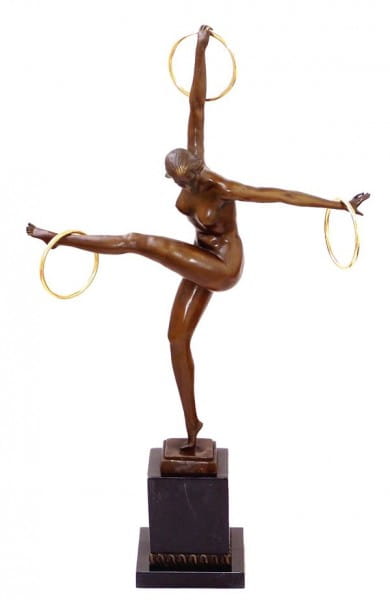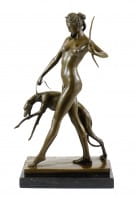€499.00 *
Prices incl. VAT, free shipping worldwide
Ready to ship today,
Delivery time appr. 3-6 workdays










Art Deco Bronze Sculpture - Dancer with Three Rings by Georges Duvernet The Dancer with... more
Product description
"Art Deco Bronze Statue - Dancer with 3 Rings - signed Duvernet"
| Weight | 4,7 kg |
Art Deco Bronze Sculpture - Dancer with Three Rings by Georges Duvernet
The Dancer with Three Rings by Georges Duvernet is a celebration of the Art Deco movement's love for elegance, energy, and modernity. This dynamic sculpture captures a female dancer in an intricate pose, balancing three rings that enhance the sculpture's sense of rhythm and flow. Created during the height of the Art Deco era, this piece exemplifies the sophistication and style that defined the 1920s and 1930s, a period that embraced innovation, bold forms, and a focus on the beauty of the human figure.
About the Artist: Georges Duvernet, A Prominent Figure in Art Deco Sculpture
Georges Duvernet, a French sculptor born in the late 19th century, made a significant impact in the world of Art Deco sculpture. Known for his work in bronze, Duvernet captured the vibrancy and sensuality of the human form, often drawing inspiration from the world of dance and performance. His work is celebrated for its fluid lines, intricate details, and emotive expression, which set his sculptures apart as symbols of the exuberance and grace of the Art Deco movement. Although not as widely known as some of his contemporaries, Duvernet’s works remain sought-after collectibles and are highly regarded in the art world.
The Creation of the Dancer with Three Rings, Inspired by the Jazz Age and Modern Dance
The Dancer with Three Rings was likely created in the 1920s or early 1930s, a time when Art Deco was at its peak. This era celebrated the liberation of movement, expression, and freedom, influenced by jazz music, flapper culture, and modern dance. Duvernet drew inspiration from the Parisian cabaret and theatre scenes, where performers captivated audiences with bold, dramatic poses and dynamic movements. The dancer’s poised stance, balancing rings with ease, reflects the grace and vitality that Art Deco embodied.
The dancer in this sculpture is captured in a moment of perfect balance, her arms extended gracefully as she manipulates the rings. The rings themselves are symbolic, representing both physical skill and the boundless energy of Art Deco design. Each ring emphasizes the circular, flowing forms that characterize Duvernet's approach, allowing the viewer to sense the motion frozen in time. Her expression is serene and focused, capturing the concentration and finesse of a performer at the height of her skill.
Material and Technique, The Allure of Bronze and Marble
The use of bronze, with its rich patina, highlights the dancer’s muscular form and delicate features, giving the piece both strength and elegance. The marble base provides a sturdy foundation, contrasting with the lightness of her pose and the delicate balance of the rings. Bronze was a favored medium in the Art Deco period, prized for its durability and ability to capture fine details. Duvernet’s meticulous attention to texture, from the smoothness of the skin to the finely rendered details of her costume, showcases his mastery of the medium.
The Significance of Art Deco in Sculpture
The Art Deco movement was defined by its embrace of modern technology, streamlined forms, and opulent materials. In sculpture, this translated into pieces that emphasized motion, freedom, and the human form. Artists like Duvernet captured the excitement of the era, producing works that embodied both the technical innovation and cultural shifts of the time. This sculpture, with its celebration of dance and poise, is an ideal representation of the Art Deco period’s fascination with movement, beauty, and modernity.
A Collector’s Treasure, The Lasting Appeal of Duvernet's Work
For collectors, Dancer with Three Rings is more than a decorative piece; it is a symbol of Art Deco’s lasting appeal and the timeless artistry of Georges Duvernet. The piece resonates with admirers of Art Deco for its balance, elegance, and representation of 1920s sophistication. Duvernet’s work is cherished for its ability to convey both the physical and emotional expression of dance, capturing a spirit that is as relevant and admired today as it was nearly a century ago.
Conclusion: A Testament to Art Deco Grace
The Dancer with Three Rings by Georges Duvernet is a captivating tribute to the Art Deco movement’s fascination with elegance, modernity, and the human form. Through meticulous craftsmanship and a profound understanding of balance and poise, Duvernet has created a timeless masterpiece that continues to enchant and inspire. This sculpture stands as a testament to the beauty of Art Deco design, capturing the energy and grace of an era defined by innovation, glamour, and the celebration of the human spirit.
The Dancer with Three Rings by Georges Duvernet is a celebration of the Art Deco movement's love for elegance, energy, and modernity. This dynamic sculpture captures a female dancer in an intricate pose, balancing three rings that enhance the sculpture's sense of rhythm and flow. Created during the height of the Art Deco era, this piece exemplifies the sophistication and style that defined the 1920s and 1930s, a period that embraced innovation, bold forms, and a focus on the beauty of the human figure.
About the Artist: Georges Duvernet, A Prominent Figure in Art Deco Sculpture
Georges Duvernet, a French sculptor born in the late 19th century, made a significant impact in the world of Art Deco sculpture. Known for his work in bronze, Duvernet captured the vibrancy and sensuality of the human form, often drawing inspiration from the world of dance and performance. His work is celebrated for its fluid lines, intricate details, and emotive expression, which set his sculptures apart as symbols of the exuberance and grace of the Art Deco movement. Although not as widely known as some of his contemporaries, Duvernet’s works remain sought-after collectibles and are highly regarded in the art world.
The Creation of the Dancer with Three Rings, Inspired by the Jazz Age and Modern Dance
The Dancer with Three Rings was likely created in the 1920s or early 1930s, a time when Art Deco was at its peak. This era celebrated the liberation of movement, expression, and freedom, influenced by jazz music, flapper culture, and modern dance. Duvernet drew inspiration from the Parisian cabaret and theatre scenes, where performers captivated audiences with bold, dramatic poses and dynamic movements. The dancer’s poised stance, balancing rings with ease, reflects the grace and vitality that Art Deco embodied.
The dancer in this sculpture is captured in a moment of perfect balance, her arms extended gracefully as she manipulates the rings. The rings themselves are symbolic, representing both physical skill and the boundless energy of Art Deco design. Each ring emphasizes the circular, flowing forms that characterize Duvernet's approach, allowing the viewer to sense the motion frozen in time. Her expression is serene and focused, capturing the concentration and finesse of a performer at the height of her skill.
Material and Technique, The Allure of Bronze and Marble
The use of bronze, with its rich patina, highlights the dancer’s muscular form and delicate features, giving the piece both strength and elegance. The marble base provides a sturdy foundation, contrasting with the lightness of her pose and the delicate balance of the rings. Bronze was a favored medium in the Art Deco period, prized for its durability and ability to capture fine details. Duvernet’s meticulous attention to texture, from the smoothness of the skin to the finely rendered details of her costume, showcases his mastery of the medium.
The Significance of Art Deco in Sculpture
The Art Deco movement was defined by its embrace of modern technology, streamlined forms, and opulent materials. In sculpture, this translated into pieces that emphasized motion, freedom, and the human form. Artists like Duvernet captured the excitement of the era, producing works that embodied both the technical innovation and cultural shifts of the time. This sculpture, with its celebration of dance and poise, is an ideal representation of the Art Deco period’s fascination with movement, beauty, and modernity.
A Collector’s Treasure, The Lasting Appeal of Duvernet's Work
For collectors, Dancer with Three Rings is more than a decorative piece; it is a symbol of Art Deco’s lasting appeal and the timeless artistry of Georges Duvernet. The piece resonates with admirers of Art Deco for its balance, elegance, and representation of 1920s sophistication. Duvernet’s work is cherished for its ability to convey both the physical and emotional expression of dance, capturing a spirit that is as relevant and admired today as it was nearly a century ago.
Conclusion: A Testament to Art Deco Grace
The Dancer with Three Rings by Georges Duvernet is a captivating tribute to the Art Deco movement’s fascination with elegance, modernity, and the human form. Through meticulous craftsmanship and a profound understanding of balance and poise, Duvernet has created a timeless masterpiece that continues to enchant and inspire. This sculpture stands as a testament to the beauty of Art Deco design, capturing the energy and grace of an era defined by innovation, glamour, and the celebration of the human spirit.
Wide: 37 cm
High: 60 cm
Depth: 12 cm
Weight: 4,7 kg
100% Bronze
Related links to "Art Deco Bronze Statue - Dancer with 3 Rings - signed Duvernet"
Read, write and discuss reviews... more
Customer evaluation for "Art Deco Bronze Statue - Dancer with 3 Rings - signed Duvernet"
Write an evaluation
Evaluations will be activated after verification.
Our advantages
free shipping
Worldwide free shipping
14 days money back
You can cancel your order
within 14 days
secure payment services
Paypal, Master Card, Visa, American Express and more























































